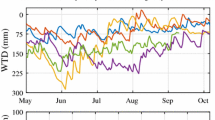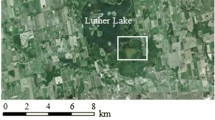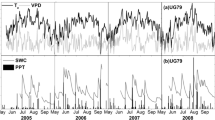Abstract
Ecosystem respiration (ER) is an important but poorly understood part of the carbon (C) budget of peatlands and is controlled primarily by the thermal and hydrologic regimes. To establish the relative importance of these two controls for a large ombrotrophic bog near Ottawa, Canada, we analyzed ER from measurements of nighttime net ecosystem exchange of carbon dioxide (CO2) determined by eddy covariance technique. Measurements were made from May to October over five years, 1998 to 2002. Ecosystem respiration ranged from less than 1 μmol CO2 m−2 s−1 in spring (May) and fall (late October) to 2–4 μmol CO2 m−2 s−1 during mid-summer (July-August). As anticipated, there was a strong relationship between ER and peat temperatures (r2 = 0.62). Q10 between 5° to 15°C varied from 2.2 to 4.2 depending upon the choice of depth where temperature was measured and location within a hummock or hollow. There was only a weak relationship between ER and water-table depth (r2 = 0.11). A laboratory incubation of peat cores at different moisture contents showed that CO2 production was reduced by drying in the surface samples, but there was little decrease in production due to drying from below a depth of 30 cm. We postulate that the weak correlation between ER and water table position in this peatland is primarily a function of the bog being relatively dry, with water table varying between 30 and 75 cm below the hummock tops. The dryness gives rise to a complex ER response to water table involving i) compensations between production of CO2 in the upper and lower peat profile as the water table falls and ii) the importance of autotrophic respiration, which is relatively independent of water-table position.





Similar content being viewed by others
References
Arneth A, Kurbatova J, Kolle O, Shibistrova OB, Lloyd J, Schulze E-D. 2002. Comparative ecosystem-atmosphere exchange of energy and mass in a European Russian and a central Siberian bog II. Interseasonal and interannual variability of CO2 fluxes. Tellus B 54:514–30
Aubinet M and others. 2000. Estimates of annual net carbon and water exchange of European forests: The EUROFLUX methodology. Adv Ecol Res 30:113–75
Aurela M, Tuovinen J-P, Laurila T. 1998. Carbon dioxide exchange in a subarctic peatland ecosystem in northern Europe measured by eddy covariance technique. J Geophys Res 103:11289–301
Aurela M, Laurila T, Tuovinen J-P. 2001. Seasonal CO2 balances of a subarctic mire. J Geophys Res 106:1623–37
Baldocchi DD, others. 2001. Fluxnet: A new tool to study the temporal and spatial variability of ecosystem-scale carbon dioxide, water vapor and energy flux densities. Bull Amer Meteorol Soc 82:2415–34
Bridgham SD, Richardson CJ. 1992. Mechanisms controlling soil respiration (CO2 and CH4) in southern peatlands. Soil Biol Biochem 24:1089–99
Bubier JL, Crill PM, Moore TR, Savage K, Varner RK. 1998. Seasonal patterns and controls on net ecosystem CO2 exchange in a boreal peatland complex. Global Biogeochem Cycles 12:703–14
Bubier JL, Bhatia G, Moore TR, Roulet NT, Lafleur PM. 2003a. Spatial and temporal variability in growing season net ecosystem carbon dioxide exchange at a large peatland in Ontario, Canada. Ecosystems 6:353–67
Bubier J, Crill P, Mosedale A, Frolking S, Linder E. 2003b. Peatland responses to varying interannual moisture conditions as measured by automatic CO2 chambers. Global Biogeochem Cycles 17:doi:10.1029/2002GB0019
Chapman SJ, Thurlow M. 1996. The influence of climate on CO2 and CH4 emissions from organic soils. Agric For Meteorol 79:205–17
Christensen TR, Jonasson S, Callaghan TV, Harstrom M. 1999. On potential CO2 release from tundra soils in a changing climate. Appl Soil Ecol 11:127–34
Enquist BJ, Economo EP, Huxman TE, Allen AP, Ignace DD, Gillooly JF. 2003. Scaling metabolisms from organisms to ecosystems. Nature 423:639–42
Fraser CJD, Roulet NT, Lafleur PM. 2001. Groundwater flow patterns in a large peatland. J Hydrol 246:142–54
Frolking S, Roulet NT, Moore TR, Richard PJH, Lavoie M, Muller SD. 2001. Modelling northern peatland decomposition and peat accumulation. Ecosystems 4:479–98
Frolking S, Roulet NT, Moore TR, Lafleur PM, Bubier JL, Crill PM. 2002. Modeling the seasonal to annual carbon balance of Mer Bleue bog, Ontario, Canada. Global Biogeochem Cycles 16:doi:10.1029/2001GB1457
Funk DW, Pullman ER, Peterman KM, Crill, Billings WD. 1994. Influence of water table on carbon dioxide, carbon monoxide, and methane fluxes from taiga bog microcosms. Global Biogeochem Cycles 8:271–78
Giardina CP, Ryan MG. 2000. Evidence that decomposition rates of organic carbon in mineral soil do not vary with temperature. Nature 404:858–61
Gorham E. 1991. Northern peatlands: Role in the carbon balance and probable responses to climatic warming. Ecol Appl 1:182–95
Goulden ML, Munger JW, Fan SM, Daube BC, Wofsy SC. 1996. Measurement of carbon storage by longterm eddy correlation: Methods and a critical assessment of accuracy. Global Change Biol 2:169–82
Goulden ML, Daube BC, Fan S-M, Sutton DJ, Bazzaz A, Munger JW, Wofsy SC. 1997. Physiological response of black spruce forest to weather. J Geophys Res 102:28987–96
Grace J, Rayment M. 2000. Respiration in the balance. Nature 404:819–20
Hollinger DY, Kelliher FM, Byers JN, Hunt JE, McSeveny TM, Weir PL. 1994. Carbon dioxide exchange between an undisturbed old-growth temperate forest and the atmosphere Ecology 75:134–50
Lafleur PM, Roulet NT, Admiral SW. 2001. Annual cycle of CO2 exchange at a bog peatland. J Geophys Res 106:3071–81
Lafleur PM, Roulet NT, Bubier JL, Frolking S, Moore TR. 2003. Interannual variability in the peatland-atmosphere carbon dioxide exchange at an ombrotrophic bog. Global Biogeochem Cycles 17:doi:10.1029/2002GB001983
Law BE, Ryan MG, Anthoni PM. 1999. Seasonal and annual respiration of a ponderosa pine ecosystem. Global Change Biol 5:169–82
Letts MG, Roulet NT, Comer NT, Skarupa MR, Verseghy DL. 2000. Parameterization of peatland hydraulic properties for the Canadian Land Surface Scheme. Atmosphere-Ocean 38:141–60
Linn DM, Doran JW. 1984. Effect of water-filled pore space on carbon dioxide and nitrous oxide production in tilled and non-tilled soils. Soil Sci Soc Am J 48:1267–72
Melillo JM, Steudler PA, Aber JD, Newkirk K, Lux H, Bowles FP, Catricala C, Magill A, Aherns T, Morrisseau S. 2002. Soil warming and carbon-cycle feedbacks to the climate system. Science 298:2173–76
Moore TR, Dalva M. 1993. The influence of temperature and water table position on carbon dioxide and methane emissions from laboratory columns of peatland soils. J Soil Sci 44:651–64
Moore TR, Dalva M. 1997. CH4 and CO2 exchange potentials of peat soils in aerobic and anaerobic laboratory incubations. Soil Biol Biochem 29:1157–64
Moore T, Bubier J, Lafleur P, Frolking S, Roulet N. 2002. Plant biomass, production and CO2 exchange in an ombrotrophic bog. J Ecol 90:25–36
Nazaroff WW. 1992. Radon transport from soil to air. Rev Geophys 30:137–60
Neumann HH, den Hartog G, King KK, Chipanshi AC. 1994. Carbon dioxide fluxes over a raised open bog at the Kinosheo Lake tower site during the Northern Wetlands Study (NOWES). J Geophys Res 99:1529–38
Nieven JP, Jacobs CMJ, Jacobs AFG. 1998. Diurnal and seasonal variation of carbon dioxide exchange from a former true raised bog. Global Change Biol 4:823–50
Nordstroem C, Soegaard H, Christensen TR, Friborg T, Hansen BU. 2001. Seasonal carbon dioxide balance and respiration of a high-arctic fen ecosystem in NE-Greenland. Theor Appl Climatol 70:149–66
Oechel WC, Voulitis GL, Hastings SJ, Ault RP Jr, Bryant P. 1998. The effect of water table manipulation and elevated temperature on the CO2 flux of wet sedge tundra ecosystems. Global Change Biol 4:77–90
Reichstein M and others. 2003. Modeling temporal and large-scale spatial variability of soil respiration from soil water availability, temperature and vegetation productivity indices. Global Biogeochem Cycles 17:doi:10.1029/2003GB002035
Riley J. 1983. Peatland Inventory Project. Geological Survey, Ontario Ministry of Natural Resources, Miscellaneous Paper 119, Toronto, Ontario, Canada
Scanlon D, Moore TR. 2000. CO2 production from peatland soil profiles: the influence of temperature, oxic/anoxic conditions and substrate. Soil Sci 165:153–60
Shurpali NJ, Verma SB, Kim J, Arkebauer TJ. 1995. Carbon dioxide exchange in a peatland ecosystem. J Geophys Res 100:14319–26
Silvola J, Alm J, Ahlholm U, Nykänen H, Martikainen PJ. 1996a. CO2 fluxes from peat in boreal mires under varying temperature and moisture conditions. J Ecol 84:219–28
Silvola J, Alm J, Ahlholm U, Nykänen H, Martikainen PJ. 1996b. The contribution of plant roots to CO2 fluxes from organic soils. Biol Fert Soils 23:126–31
Skopp J, Jawson MD, Doran JW. 1990. Steady-state aerobic microbial activity as a function of soil water content. Soil Sci Soc Am J 54:1619–25
Soegaard H, Nordstroem C. 1999. Carbon dioxide exchange in a high-arctic fen estimated by eddy covariance measurements and modelling. Global Change Biol 5:547–62
Suyker AE, Verma SB, Arkebauer TJ. 1997. Season-long measurement of carbon dioxide exchange in a boreal fen. J Geophys Res 102:29021–28
Svensson BH. 1980. Carbon dioxide and methane fluxes from the ombrotrophic parts of a subarctic mire. Ecol Bull Stockholm 30:235–50
Updegraff K, Pastor J, Bridgham SD, Johnston CA. 1995. Environmental and substrate controls over carbon and nitrogen mineralization in northern wetlands. Ecol Appl 5:151–63
Updegraff K, Bridgham SD, Pastor J, Weishampel P, Harth C. 2001. Response of CO2 and CH4 emissions in peatlands to warming and water table manipulation. Ecol Appl 11:311–26
Valentini R, Matteucci G, Dolman AJ, Schulze E-D, Rebmann C, others. 2000. Respiration as the main determinant of carbon balance in European forests. Nature 404:861–65
Vourlitis GL, Oechel WC. 1999. Eddy covariance measurements of net CO2 and energy fluxes of an Alaskan tussock tundra. Ecology 80:686–701
Waddington JM, Rotenberg PA, Warren FJ. 2001. Peat CO2 production in a natural and cutover peatland: Implications for restoration. Biogeochemistry 54:115–30
Acknowledgements
This project has been supported by funds from the NSERC Strategic Grant Program, NSERC Discovery Grants Program, the NSERC/CFCAS/BIOCAP Canada Fluxnet Canada Research Network, and the NASA Terrestrial Ecology and EOS Interdisciplinary Science Programs (to SF). We thank the National Capital Commission for permission to use Mer Bleue and Gershon Rother for his assistance over the last five years. We thank Adina Gillespie for laboratory assistance and Jill Bubier for insightful comments and suggestions. The authors are grateful to two anonymous reviewers and Ecosystems subject editor Dr. G. Shaver for their helpful suggestions on this manuscript.
Author information
Authors and Affiliations
Corresponding author
Rights and permissions
About this article
Cite this article
Lafleur, P., Moore, T., Roulet, N. et al. Ecosystem Respiration in a Cool Temperate Bog Depends on Peat Temperature But Not Water Table. Ecosystems 8, 619–629 (2005). https://doi.org/10.1007/s10021-003-0131-2
Received:
Accepted:
Published:
Issue Date:
DOI: https://doi.org/10.1007/s10021-003-0131-2




